|
The
qipao is recognised by most people as the classic
Chinese garment for women. Qipao is a Mandarin word
which means Manchu banner robe. Judging from
its name, the qipao originates from Manchu dress
of the Qing dynasty. It was a simple garment, essentially
made from two pieces of cloth cut to follow the form
of a woman's body, with slits at the sides to allow
for ease of movement. It was an extremely versatile
garment that could be made from any sort of fabric,
to different lengths and with long or short sleeves.
Many people will be more familiar with the Cantonese
term for the garment which is cheungsam, meaning
long shirt.
Cheungsam
gallery
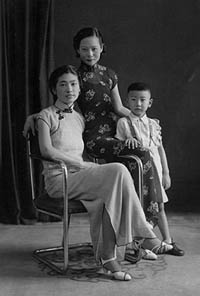
Photo courtesy: Wang family.
|
|
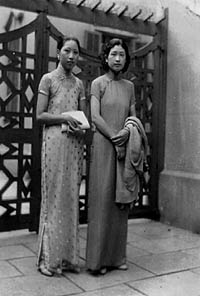
Photo courtesy: Wang family.
|
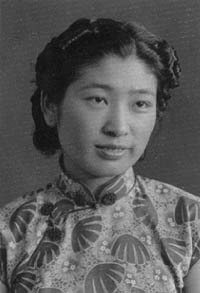
Photo courtesy: Wang family.
|
|
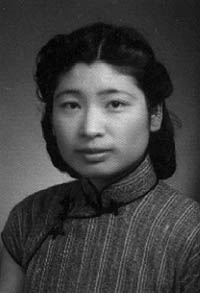
Photo courtesy: Wang family.
|
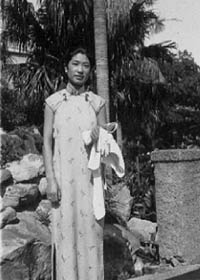
Photo courtesy: Wang family.
|
|

Photo courtesy: Wang family.
|
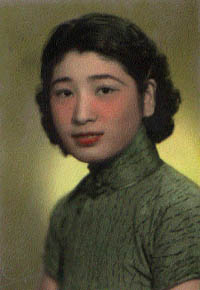
Photo courtesy: Wang family.
|
|
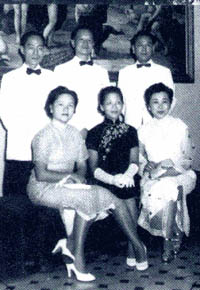
Photo courtesy: Wynne Shih.
|
Political,
economic and social change
The early twentieth century was a period of political,
economic and social change. Increased contact with the
West, through trade, resulted in an exchange of culture
and ideas. This was a significant time for women.
A
new Western concept was that of gender equality, and
this encouraged community leaders in their campaign
for women's freedom: to receive an education, to choose
a career and determine their marriage partners. Educated
women and those from wealthy families took the opportunity
to experiment with these new possibilities. (Roberts,
1997: 55)
The
cheungsam - which was born alongside a growing
awareness of women's rights - symbolised this transition.
It is significant that Chinese women, after being
released from such restrictive traditions, selected
the cheungsam as their national dress. The
women portrayed on the calendar posters dressed in
sleeveless cheungsam with high side-slits,
illustrate one aspect of women's new found freedom.
(Roberts, 1997: 64)
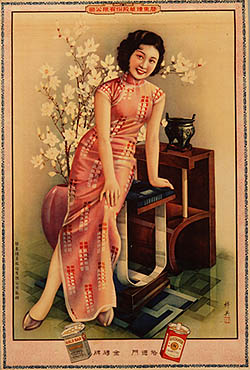
Advertising poster for Qidong Tobacco
Company showing a fashionable woman wearing a cheungsam.
Colour lithograph by Hang Zhiying, made in Shanghai,
China during the late 1930s. Powerhouse Museum collection.
95/29/2 |
The
centre of Chinese fashion at the turn of the century
was the coastal city of Shanghai. A leading and prosperous
metropolis in China before World War II, Shanghai
had such a reputation as a centre for women's fashion
it was called the Paris of the East. The evolution
of the cheungsam in Hong Kong, along with other
cities in China, kept abreast of the trends in Shanghai.
The earliest style of cheungsam was loosely
fitted and ankle length. Over time, hem lines rose
to mid-calf or knee length. Sleeves varied, from long
to medium length to small capped sleeves, or a Western-style
frilled sleeve might be added. Some were sleeveless.
The stand collars were sometimes stiffened and could
go as high as the ears. The cheungsam became
increasingly tight-fitting and side-slits rose higher.
(Roberts, 1997: 59-60)
The
cheungsam was the most popular form of female
dress in Hong Kong from the 1930s to the 1960s. It has
remained popular with certain groups of women in Hong
Kong, Taiwan and in Chinese communities throughout the
world.
Although
the collar and right-fastening lapel of Manchu dress
are reflected in the cheungsam that's where the
similarity ends. The loose fitting styles and the extended
wide sleeves of late 19th century dress were quite different
to the form fitting cheungsam.
Fabrics
for cheungsam
The cheungsam was made from a variety of fabrics
depending on the season and the occasion:
| Silk |
Synthetics |
| Brocade |
Wool |
| Velvet |
Cotton |
| Lace |
Satin |
Silk
and cotton wadding and fur linings were also used.
Activity
Next to each fabric write the season and an occasion
it might be used for.
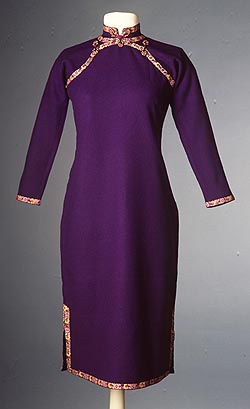
Woollen cheungsam, made in
Hong Kong in the 1940s. Powerhouse Museum collection.
97/167/5. Photo by Sue Stafford. |
Fabric
decoration
Indantren dye (originally from India) was widely used
for plain dyed fabrics worn more frequently by working
women. In addition to beautiful, high quality silk brocade
fabrics, more affluent women were able to have highly
decorated cheungsam featuring:
- embroidery
- sequins
- application
of trims.
Embroidery
patterns were initially traditional, featuring flowers
and symbolic motifs. As contact with the West increased
the influence was seen in the motifs.
Toggles
Decorative toggles, known as huaniu, are made
to fasten traditional style qipao or cheungsam.
The knotted head is regarded as male and the pair with
an eye, female. Huaniu used for collars are usually
the same size whereas those used to fasten the right
of the lapel are different sizes; the smaller section
being sewn close to the shoulder.
While
the cheungsam has varied over time in shape,
colour, material and design features, one fundamental
element has remained the same: this is the knotted
buttons and loops generally known as huaniu
or panhuaniu, which are stitched to fasten
the collar and lapel. Huaniu may be a small
feature but they should not be overlooked: they represent
the soul of the cheungsam and provide a distinctive
Chinese character. Huaniu are the product of
thousands of years of traditional knotting craft and
the designs and compositions vary from the plain to
intricate. Traditional designs include floral, animal
and insect motifs, and auspicious symbols, such as
pomegranates and the Chinese character shou,
signifying fertility and longevity. Most huaniu
on cheungsam are designed to match the pattern
of the fabric and the colour of the braided trim on
the collar cuff and hem. (Roberts, 1997: 61-2)
Activity
1. Look at the huaniu used on the cheungsams
in the Cheungsam gallery.
2. Use fabric scraps to create at least one huaniu
or as it is sometimes known, a frog and Chinese ball
button. To make these you will need to make some self-filled
tubing or rouleau.
Alternatively
create a paper scrolling picture to design a huaniu.

Courtesy: Reader's Digest (Australia)
|

Frog closure Courtesy: Reader's Digest (Australia)
|
|
Courtesy:
Reader's Digest (Australia)
|
Sewing
the cheungsam
The cheungsam has traditionally been made by
tailors, many of whom were trained in Shanghai, where
fine tailoring is a tradition. Shanghai tailors 'have
traditionally sewn the outerpart of the cheungsam
and the piping entirely by hand'. (Roberts, 1997: 66)
…
sophisticated skills are required in producing cheungsam
to fit customers of various body shapes and ages.
The garment could be so fitted that it was affected
by a change in underwear … body-hugging cheungsam…
could require as many as ten darts. (Roberts, 1997:
67)
Cheungsam
of the fifties and sixties
In the fifties and sixties the cheungsam was
the glamour garment - virtually everyone had at least
one. Different styles of cheungsam differentiated
one's class or profession. The 1960s movie The World
of Suzie Wong featured Suzie Wong wearing a mini
cheungsam.
Who
wears the cheungsam today?
By the end of the seventies few Chinese women wore the
cheungsam; it was mostly worn by:
- older
women 'usually with a Western-style jacket of matching
material for more formal dress' (Roberts, 1997: 63).
Many of these women go to the same tailor they have
used for years, the tailor has their measurements
and knows their preference for various fabrics.
- actors
and wealthy women still wear what some regard as Hong
Kong's national costume.
- school
girls comprise a large clientele for the cheungsam
tailor as a number of Hong Kong schools continue to
use it as the basis for their school uniform. The
uniforms are tailored for each student based on their
measurements but unlike the ones worn by the actors
it is loose fitting - more like the traditional male
long robe or cheungsam.

Qipao, wool, made
in Hong Kong in the 1950s. Private collection. Australia.
|

Students from the True Light Middle
School, Hong Kong, wearing cheungsam, 1996.
Courtesy: The True Light Middle School (Roberts,
1997: 68). |
The
cheungsam in the 21st century
After the handover of Hong Kong to China in 1997 there
has been an increased interest in symbols of national
identity such as dress. Young designers and young people
in Hong Kong are wearing the cheungsam in new
and different ways. Charmaine Leung, a fashion designer
wears her off-the-peg cheungsam 'fitted and made
from traditional style silk brocade, in colours such
as red, black or dark blue.' with 'loafers, a cardigan
wrapped round her waist and backpack.' (Roberts, 1997:
73)

Charmaine Leung, fashion designer
and teacher, wearing a cheungsam, in January 1997.
Photo by Piera Chen. Courtesy: Dr Hazel Clark. |
|